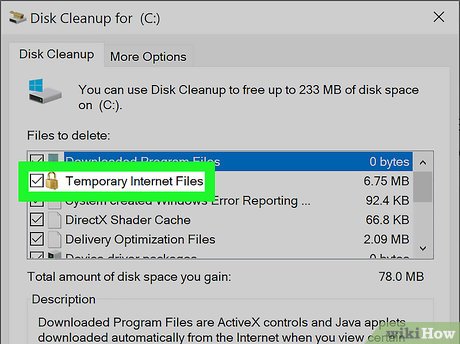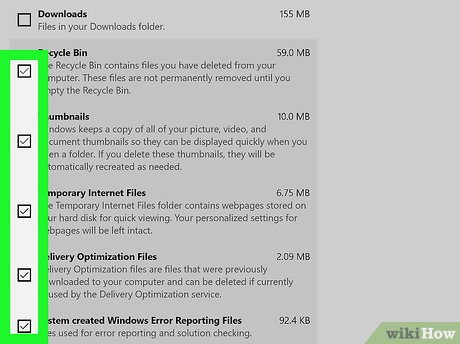How to Clear Temp Files in Windows 10
Method 1 of 3:
Using Disk Cleanup
-
 Open Disk Cleanup. You can search 'disk cleanup' in the search bar in the taskbar and click the first result, which is the app. This is the easiest and least involved method for cleaning up temporary files on your Windows 10 computer.
Open Disk Cleanup. You can search 'disk cleanup' in the search bar in the taskbar and click the first result, which is the app. This is the easiest and least involved method for cleaning up temporary files on your Windows 10 computer.- You can also press the Windows key+S to open the search function if you can't find it in the taskbar.
-
 Click to check the boxes next to "Temporary Internet Files" and "Temporary Files." You'll see how much space they will free up along the right side of the columns.
Click to check the boxes next to "Temporary Internet Files" and "Temporary Files." You'll see how much space they will free up along the right side of the columns.- Suggested boxes to delete are checked by default; you can leave these checked and delete these files or you can click to uncheck the box and not delete these files.
-
 Click Delete Files. Click 'OK' to confirm the action when a box pops up. When you continue, that box will disappear and you'll see a progress bar of the deletion, which will disappear when it's done.[1]
Click Delete Files. Click 'OK' to confirm the action when a box pops up. When you continue, that box will disappear and you'll see a progress bar of the deletion, which will disappear when it's done.[1]
Method 2 of 3:
Using Settings
-
 Open your Windows Settings. You can click on the Start icon and then the gear to open Settings.
Open your Windows Settings. You can click on the Start icon and then the gear to open Settings.
-
 Click System. It's the computer icon.
Click System. It's the computer icon. -
 Click Storage. This is near the bottom of the menu on the left.
Click Storage. This is near the bottom of the menu on the left. -
 Click the drive where Windows 10 is installed. It usually has a Windows logo over the drive icon and might be called 'This PC.'
Click the drive where Windows 10 is installed. It usually has a Windows logo over the drive icon and might be called 'This PC.' -
 Click Temporary Files. The number here represents how much space the temporary files are taking up. The next page shows you all the files that are considered temporary files, including files in the Downloads folder, files in the Recycling Bin, and thumbnails.
Click Temporary Files. The number here represents how much space the temporary files are taking up. The next page shows you all the files that are considered temporary files, including files in the Downloads folder, files in the Recycling Bin, and thumbnails. -
 Click to check the boxes next to the files you want to delete.
Click to check the boxes next to the files you want to delete. -
 Click Remove files. You'll see a progress bar of the deletion.[2]
Click Remove files. You'll see a progress bar of the deletion.[2]
Method 3 of 3:
Clearing Temporary Files Manually
-
 Press ⊞ Win+R to open the Run box. This is the most involved method of clearing your temporary files.
Press ⊞ Win+R to open the Run box. This is the most involved method of clearing your temporary files. -
 Type '%temp%' in the Run box and press ↵ Enter. You'll be directed to the folder that contains all the temporary files.
Type '%temp%' in the Run box and press ↵ Enter. You'll be directed to the folder that contains all the temporary files. -
 Select all files and folders. You can click the first file, press and hold ⇧ Shift and click the last file, or you can click the first file and press Ctrl+A to select them all.
Select all files and folders. You can click the first file, press and hold ⇧ Shift and click the last file, or you can click the first file and press Ctrl+A to select them all. -
 Right-click anywhere in the file and click Delete. You will need an administrator account to do this.
Right-click anywhere in the file and click Delete. You will need an administrator account to do this.- All those files are moved into the Recycle Bin and can be restored if needed.
4 ★ | 3 Vote
You should read it
- How to Delete Temporary Files in Windows 7
- Steps to remove temporary files stored on Kaspersky
- Automatically delete temporary files every time a Windows 10 computer is opened
- Free up space on Windows 10 by deleting temporary files
- Delete junk files, temporary files in Windows
- How to Rid Your Computer of Temporary Files















 How to Dual Boot Windows 10 and Ubuntu 16.04
How to Dual Boot Windows 10 and Ubuntu 16.04 How to Enable the Windows Subsystem for Linux
How to Enable the Windows Subsystem for Linux How to Turn Off Automatic Updates in Windows 10
How to Turn Off Automatic Updates in Windows 10 How to Pin a Program to the Windows 10 Taskbar
How to Pin a Program to the Windows 10 Taskbar How to Fix Microsoft Store Downloading Problems
How to Fix Microsoft Store Downloading Problems How to Screenshot in Windows 10
How to Screenshot in Windows 10